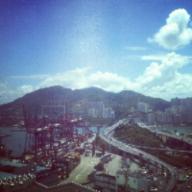珠江三角洲的英文名稱是什麼
2006-11-09 6:47 am
珠江三角洲的英文名稱是什麼?
回答 (5)
2006-11-09 6:50 am
✔ 最佳答案
Pearl River Delta
Chinese:
珠江三角洲
Mandarin
Hanyu Pinyin:
Zhū Jiāng Sānjiǎozhōu
Cantonese
IPA:
[tsy55 kɔŋ55 sɑm55 kɔk33 tsɐʊu55]
Jyutping:
zyu1 gong1 saam1 gok3 zau1
圖片參考:http://upload.wikimedia.org/wikipedia/en/thumb/5/5f/Frontmap.gif/180px-Frontmap.gif
The Pearl River Delta (PRD) in China occupies the low-lying areas alongside the Pearl River estuary where the Pearl river flows into the South China Sea. Since the "Open Door Policy" was adopted by the Communist Party of China in the late 1970s, the portion of the delta in Guangdong Province has become one of the leading economic regions and a massive manufacturing center of mainland China. The PRC government hopes that the manufacturing in Guangdong, combined with the financial and service economy and traditional western influence in Hong Kong will create an economic gateway attracting foreign capital throughout mainland China.
[edit] Location and demographics
The PRD covers eight prefectures of the Guangdong Province, namely Guangzhou, Shenzhen, Zhuhai, Dongguan, Zhongshan, Foshan, Huizhou (only includes Huizhou City, Huiyang, Huidong, Boluo), Jiangmen and Zhaoqing (only includes Zhaoqing City, Gaoyao and Sihui), and the SARs of Hong Kong and Macau.
Geographically and geologically speaking, Shenzhen and Hong Kong are not part of the PRD; however economically and culturally they are considered part of the PRD.
The eastern side of the PRD (Shenzhen, Dongguan, Guangzhou) is the most developed economically. The western areas (Zhuhai, Zhongshan, Jiangmen) are open for development. New transport links between Hong Kong, Macau and Zhuhai in the PRD are expected to open up new areas for development and facilitate trade within the region. A major transportation development within the region, the Pearl River Bridge Project, is targeted for completion in 2006. The 29-kilometre Y-shaped bridge will be among the longest in the world.
Until approximately around 1985, the PRD had been mainly dominated by farms and small rural villages, but after the economy was reformed and opened, a flood of investment turned it into the mainland's economic powerhouse. The PRD's startling growth was fuelled by foreign investment coming largely from Hong Kong manufacturers that moved their operations into the PRD. In 2003, Hong Kong companies employed 11 million workers in their PRD operations
2006-11-09 7:05 am
珠江三角洲的英文名稱是:Zhujiang Delta
http://www.babelfish.altavista.com/tr
http://www.babelfish.altavista.com/tr
2006-11-09 6:54 am
2006-11-09 6:51 am
珠江三角洲 = Pearl River Delta
希望幫到你!
希望幫到你!
2006-11-09 6:49 am
Peral River Delta
2006-11-08 22:50:15 補充:
SORRY 打錯字...是 PEARL RIVER DELTA
2006-11-08 22:50:15 補充:
SORRY 打錯字...是 PEARL RIVER DELTA
收錄日期: 2021-04-26 16:42:17
原文連結 [永久失效]:
https://hk.answers.yahoo.com/question/index?qid=20061108000051KK04969



